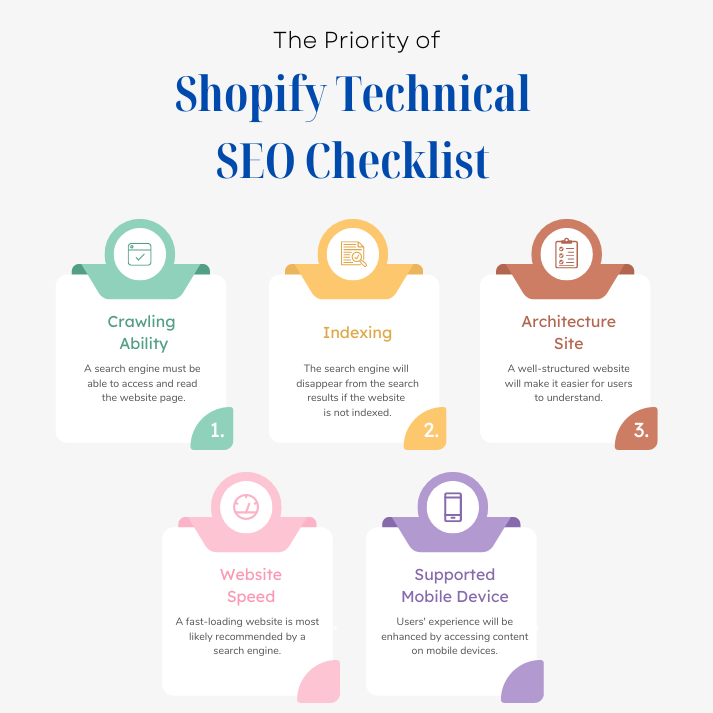Shopify Technical SEO Checklist: A Comprehensive Guide to Boost Your Store’s Performance
When it comes to running a successful Shopify store, you can’t ignore the power of SEO. Shopify is a user-friendly platform that allows you to build and manage your e-commerce business. However, while it handles a lot of SEO basics out of the box, fine-tuning your technical SEO can significantly impact how your store ranks on search engines. Technical SEO involves optimizing your website’s infrastructure, making it easier for search engines to crawl, index, and rank your content.
In this detailed checklist, we will go over the key areas of technical SEO that Shopify store owners need to focus on.
Enable SSL Certificates
A secure website is a must for both users and search engines. Shopify provides SSL (Secure Sockets Layer) certificates for all stores, ensuring that your site runs on HTTPS. Google prioritizes secure sites, so enabling SSL is critical for SEO.
- Go to your Shopify dashboard.
- Navigate to Online Store > Domains and ensure your primary domain uses HTTPS.
- Check for the green lock symbol next to your URL to verify that SSL is working correctly.
Optimize URL Structure
A clean and simple URL structure is essential for search engine crawlers to understand your site’s hierarchy and content. Shopify creates URLs automatically, but they can sometimes be too complex.
- Use descriptive and keyword-focused URLs. Make sure product, collection, and blog post URLs contain target keywords but remain concise.
- Avoid unnecessary parameters. Shopify adds
/collections/or/products/by default in URLs, which is unavoidable, but keep any additional parameters to a minimum.Example of a good URL:
https://yourstore.com/products/blue-summer-dress
Optimize Site Speed
Page load time is one of the ranking factors for Google. Fast-loading pages also contribute to a better user experience and lower bounce rates. To improve your Shopify store’s speed:
- Compress images before uploading them (using tools like TinyPNG or Shopify’s built-in image compression).
- Limit apps that run on the front end. Each app adds extra JavaScript and CSS files, which can slow down your website.
- Use a lightweight theme that is optimized for speed (Shopify’s Debut and Dawn themes are good choices).
- Leverage browser caching and minify CSS and JavaScript files where possible.
Mobile Optimization
With the majority of online shoppers using mobile devices, having a mobile-friendly site is essential for SEO. Google uses mobile-first indexing, meaning it primarily uses the mobile version of the site for ranking and indexing.
- Use a responsive theme that automatically adapts to different screen sizes.
- Ensure buttons and links are easy to click on mobile devices.
- Avoid pop-ups or large banners that disrupt mobile users.
Fix Crawl Errors
Crawl errors can prevent search engines from indexing your pages, negatively impacting your rankings. Tools like Google Search Console can help you detect crawl issues on your Shopify site.
- Sign up for Google Search Console and submit your store’s sitemap (Shopify automatically generates a sitemap.xml file).
- Regularly check for 404 errors (broken pages), server errors, or redirect chains.
- Fix broken links or set up 301 redirects for any removed pages.
Implement Structured Data
Structured data (or schema markup) helps search engines understand the content on your site better and can improve how your site is displayed in search results (e.g., rich snippets, star ratings, product prices).
- Shopify doesn’t include structured data by default, so you will need to add it manually or use an app like JSON-LD for SEO.
- For product pages, include schema for price, availability, and reviews.
- Validate your structured data using Google’s Rich Results Testing Tool.
Canonical Tags
Shopify creates multiple URLs for the same content (for example, when a product appears in multiple collections), leading to duplicate content issues. To avoid duplicate content penalties from Google, canonical tags tell search engines which URL is the preferred version.
- Shopify automatically adds canonical tags to product pages, but verify them using the Inspect URL tool in Google Search Console.
- Ensure your blog posts and other pages also have proper canonical tags.
Optimize XML Sitemap
An XML sitemap is a file that lists all the pages on your site, helping search engines understand your site structure and index your pages more efficiently.
- Shopify automatically generates and updates the sitemap.xml file, but you should still verify it in Google Search Console.
- Make sure important pages (like product, collection, and blog pages) are included in your sitemap.
- Exclude low-value or thin content pages (like tag and author archives) from being indexed.
Reduce Redirect Chains
Redirect chains occur when one URL redirects to another, which then redirects to yet another URL. This can slow down your website and confuse search engines.
- Regularly audit your redirects using tools like Screaming Frog or Ahrefs.
- Update internal links to point directly to the final destination URL, eliminating unnecessary redirects.
Set Up and Test 404 Pages
A custom 404 error page can help keep visitors on your site if they land on a broken or removed page. It can also prevent a poor user experience that could affect your SEO performance.
- Customize your Shopify 404 page to include navigation links, a search bar, and recommendations to guide users back to your active pages.
- Test your 404 page by entering a wrong URL on your domain to ensure it works correctly.
Use Internal Linking Strategically
Internal linking is an easy way to improve your Shopify store’s SEO. It helps search engines discover your content and distributes page authority across your site.
- Add relevant links to product pages, blog posts, and collections to boost your store’s internal linking.
- Use descriptive anchor text to help search engines understand the context of the linked page.
For example:
Instead of “click here,” use “shop our summer dresses” as the anchor text.
Check Indexability of Key Pages
Your important pages must be indexable by search engines. To ensure search engines can properly crawl and index your pages:
- Avoid noindex tags on key pages like products and collections.
- Ensure your robots.txt file is not blocking critical pages from being crawled.
- Use Google Search Console to verify the index status of your pages.
Enable Lazy Loading for Images
Lazy loading defers the loading of offscreen images until the user scrolls to them, improving initial page load times. Shopify themes may not have lazy loading enabled by default.
- Enable lazy loading for images using either a third-party app or by manually editing your theme’s code.
- Test your site to make sure lazy loading does not impact image visibility.
A well-optimized Shopify store not only improves search engine rankings but also creates a better user experience, resulting in higher traffic and conversions. By following this technical SEO checklist, you can ensure your Shopify store is ready to compete in the crowded e-commerce landscape.
Regular audits of your Shopify site’s technical SEO health are crucial to maintaining strong performance, so keep an eye on your metrics and adjust your strategies as needed.
With the right SEO practices in place, your store will be poised for success! Need Help Contact us


